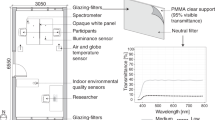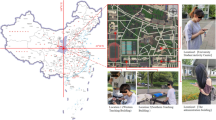Abstract
The aim of this study was to investigate the relationship between simulated solar radiation and thermal comfort. Three studies investigated the effects of (1) the intensity of direct simulated solar radiation, (2) spectral content of simulated solar radiation and (3) glazing type on human thermal sensation responses. Eight male subjects were exposed in each of the three studies. In Study 1, subjects were exposed to four levels of simulated solar radiation: 0, 200, 400 and 600 Wm−2. In Study 2, subjects were exposed to simulated solar radiation with four different spectral contents, each with a total intensity of 400 Wm−2 on the subject. In Study 3, subjects were exposed through glass to radiation caused by 1,000 Wm−2 of simulated solar radiation on the exterior surface of four different glazing types. The environment was otherwise thermally neutral where there was no direct radiation, predicted mean vote (PMV)=0±0.5, [International Standards Organisation (ISO) standard 7730]. Ratings of thermal sensation, comfort, stickiness and preference and measures of mean skin temperature (tsk) were taken. Increase in the total intensity of simulated solar radiation rather than the specific wavelength of the radiation is the critical factor affecting thermal comfort. Thermal sensation votes showed that there was a sensation scale increase of 1 scale unit for each increase of direct radiation of around 200 Wm−2. The specific spectral content of the radiation has no direct effect on thermal sensation. The results contribute to models for determining the effects of solar radiation on thermal comfort in vehicles, buildings and outdoors.


















Similar content being viewed by others
References
Beeson EJG (1978) The CSI lamp as a source of radiation for solar simulation. Light Res Technol 10(3):164–166
Blazejczyk K (1994) In: Frim J, Ducharme MB, Tikuissi P (eds) Changes of skin temperature and body heat content in fluctuating outdoor climate, 6th International Conference on Environmental Ergonomics, Conference Proceedings, Montebello,Canada, pp 226–227
Blazejczyk K, Nilsson H, Holmér I (1993) Solar heat load on man (review of different methods of estimation). Int J Biometeorol 37:125–132
Bohm M, Noren O, Holmér I, Nilsson H (1997) Special glazing to improve the thermal climate in cabs. In: Proceedings of the 4th International Conference and Exhibition, Comfort in the automotive industry, recent developments and achievements. pp 163–172
Breckenridge JR, Goldman RF (1971) Solar heat load in man. J Appl Physiol 31(5):659–663
Brooks JE, Parsons KC (1999) An ergonomics investigation into human thermal comfort using an automobile seat heated with encapsulated carbonized fabric (ECF). Ergonomics 42(5):661–673
Fung W, Parsons KC (1996) Some investigations into the relationship between car seat cover materials and thermal comfort using human subjects. J Coated Fabrics 26:147–175
Gagge AP, Stolwijk JA, Hardy JD (1967) Comfort and thermal sensations and associated physiological responses at various ambient temperatures. Environ Res 1(1):1–20
Givoni B (1976) Man, climate and architecture. Van Nostrand Reinhold, New York
Huston DR, Choukalos C, Tranowski JP, Weisman J (1996) Field measurements of seated vibrations. Society of Automotive Engineers, USA, 960477
ISO Standard 7730 (1994) Moderate thermal Environments - Determination of the PMV and PPD Indices and Specification of the Conditions for thermal Comfort, Geneva: International Standards Organisation
ISO 10551 (1995) Ergonomics of the thermal environment - Assessment of the influence of the thermal environment using subjective judgement scales, Geneva: International Standards Organisation
Madsen T, Olesen B, Reid K (1992) New methods for evaluation of the thermal environment in automotive vehicles. ASHRAE Trans 92(1):38–54
Matsunaga K, Sudo F, Tanabe S, Madsen TL (1993) Evaluation and measurement of thermal comfort in the vehicles with a new thermal manikin, 931958. Society of Automotive Engineers
Matzarakis A, Mayer H et al (1999) Applications of a universal thermal index: physiological equivalent temperature. Int J Biometeorol 43(2):76–84
McNeill MB, Parsons KC (1999) Appropriateness of international heat stress standards for use in tropical agricultural environments. Ergonomics 42(6):779–797
Moran, D, Shapiro Y, Epstein Y, Burstein R, Stroschein L, Pandolf KB (1995) Validation and adjustment of the mathematical prediction model for human rectal temperature responses to outdoor environmental conditions. Ergonomics 38(5):1011–1018
Narita C, Tanabe S, Ozeki Y, Konishi M (2001) Effects of spectral property of solar radiation on thermal sensation at the back of hands. Moving thermal comfort Standards into the 21st century, conference proceedings: pp 393–400
Nielsen B (1990) Solar heat load: heat balance during exercise in clothed subjects. Eur J Appl Physiol 60(6):452–456
Nielsen B, Kassow K, Aschengreen FE (1988) Heat balance during exercise in the sun. Eur J Appl Physiol 58(1–2):189–196
Nilsson H, Holmér I, Bohm M, Noren O (1997) Equivalent temperature and thermal sensation - comparison with subjective measurements, Proceedings of the 4th International Conference Comfort in the Automotive Industry, Recent Developments and Achievement, ATA conference, Bologna, Italy
Nilsson H, Holmér I, Bohm M, Noren O (1999) Definition and theoretical background of the equivalent temperature, 99A4082, ATA conference, Florence, Italy
Ogawa T, Sugenoya J, Ohnishi N, Natsume K, Ochiai M, Nishida M, Shinoda N, Katoh K, Imamura R (1991) Dynamic sweating response of man to infrared irradiation in various spectral regions. Int J Biometeorol 35(18):18–23
Parsons KC (1992) A thermal model of a car driver. Proceedings of the 2nd International Conference on Vehicle Comfort. PP 323–332. Associazione techica Dell’Automoblie, Bologna, Italy
Parsons KC (2003) Human thermal environments. Taylor & Francis, London, pp 248–256, ISBN: 0415237920
Parsons KC, Entwistle D (1983) An investigation into the thermal of motor car drivers. In: Kurenna Coombes (ed) Proceedings of the Ergonomics Society Conference pp 71–75. ISBN 0-85066-252-4
Parsons KC, Griffin MJ (1983) Method for predicting passenger vibration discomfort. Society of Automotive Engineers Technical Paper Series 831029
Ramanathan NL (1964) A new weighting system for mean surface temperature of the human body. J Appl Physiol 19(3):531–533
Reed MP, Schneider LW (1996) Lumber support in auto seats: conclusions from a study of preferred driving posture. Society of Automotive Engineers, USA 960477
Rohles FH, Wallis SB (1979) Comfort criteria for air conditioned automotive vehicles. Society of Automotive Engineers. INC, 790122
Roller WL, Goldman RF (1968) Prediction of solar heat load on man. J Appl Physiol 24(5):717–721
Shapiro Y, Moran D, Epstein Y, Stroschein L, Pandolf KB (1995) Validation and adjustment of the mathematical prediction model for human sweat rate responses to outdoor environmental conditions. Ergonomics 38(5):981–986
Spagnolo J, de Dear R (2003) A field study of thermal comfort in outdoor and semi-outdoor environments in subtropical Sydney Australia. Build Environ 38(5):721–738
Tanaka H, Kilada M, Taniguchi Y, Ohno Y, Shinagawa T, Aoki H (1992) Study on car air conditioning system controlled by car occupants’ skin temperature - Part 2: Development of a new air conditioning system, 920170, Society of Automotive Engineering
Temming J (1980) Comfort requirements for heating, ventilation and air conditioning in motor vehicles. Research and Development Division, Volkswagenwerk AG
Acknowledgements
This work was conducted as part of a Brite Euram funded project BRPR-CT97-0450. The authors would like to acknowledge the support and help provided by Fiat, Pilkington, Renault, Rover, Splintex, Saint Gobain and the University of Warwick.
Author information
Authors and Affiliations
Corresponding author
Rights and permissions
About this article
Cite this article
Hodder, S.G., Parsons, K. The effects of solar radiation on thermal comfort. Int J Biometeorol 51, 233–250 (2007). https://doi.org/10.1007/s00484-006-0050-y
Received:
Revised:
Accepted:
Published:
Issue Date:
DOI: https://doi.org/10.1007/s00484-006-0050-y




